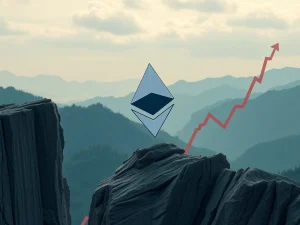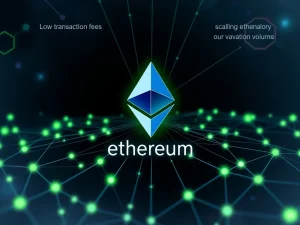Shocking Claim: Greedy Layer 2s Killing Ethereum Investment?

Is Ethereum (ETH), the second-largest cryptocurrency, facing an existential crisis? A venture capitalist has made a startling claim that greedy Layer 2 solutions are the primary reason why ETH is becoming a ‘completely dead’ investment. This bold statement has ignited a debate within the crypto community, especially as Ether’s performance against Bitcoin hits a near five-year low. Let’s dive into the details of this controversial perspective and explore the factors contributing to Ethereum’s current market position.
The Grim Diagnosis: Ethereum as a ‘Dead’ Investment
Quinn Thompson, founder of Lekker Capital, recently sparked a firestorm with his blunt assessment of Ethereum’s investment viability. He argues that despite its utility as a network, Ethereum no longer presents a compelling investment case. Thompson points to concerning trends:
- Declining Transaction Activity: The Ethereum network is reportedly seeing a decrease in the volume of transactions processed.
- User Growth Stagnation: New user adoption on the Ethereum mainnet may be slowing down.
- Fee and Revenue Reduction: Ethereum’s main layer is experiencing a drop in transaction fees and overall revenue.
Thompson emphasizes that a $225 billion market cap network showing these negative indicators raises serious questions about its investment potential. This pessimistic view is echoed by Nic Carter of Castle Island Ventures, who points to a specific culprit: greedy Layer 2 scaling solutions.
Layer 2s: Saviors or Saboteurs of Ethereum?
Layer 2 (L2) networks like Arbitrum and Optimism were designed to be Ethereum’s saviors, meant to alleviate congestion and reduce gas fees on the main Blockchain. However, Carter argues that these L2s have become ‘greedy,’ effectively siphoning value away from the Ethereum Layer 1 (L1) without adequately contributing back. He claims:
- Value Extraction: L2s are absorbing users, transactions, and crucially, fee revenue that would have otherwise gone to the Ethereum mainnet.
- Lack of Reciprocity: These L2s are allegedly not contributing enough back to the base layer to sustain its growth and value.
- Excessive Token Creation: Carter also criticizes the proliferation of new tokens within the Ethereum ecosystem, suggesting it dilutes value and confuses investors. He believes Ethereum has been “buried in an avalanche of its own tokens.”
This perspective paints a picture of L2s as parasitic entities, thriving on Ethereum’s foundation while weakening it in the long run. This raises a critical question: Are Layer 2 solutions ultimately undermining the very network they were intended to scale?
Ethereum vs. Bitcoin: A Troubling Trend
The ETH/BTC ratio, a key indicator of Ethereum’s strength relative to Bitcoin, has plummeted to its lowest point in nearly five years. This metric highlights a significant underperformance of Ether compared to Bitcoin. Consider these points:
- ETH/BTC Ratio Decline: The ratio currently sits at 0.02260, signaling a substantial loss of relative value for ETH.
- Price Performance: Ether is currently trading around $1,894, showing a 5.34% decrease over the past week and a significant 17.94% drop over the last 30 days.
- Market Downturn Impact: While the broader crypto market has experienced a downturn, Ethereum’s decline seems particularly pronounced compared to Bitcoin.
This underperformance fuels the narrative that Ethereum is losing its appeal as a top-tier crypto investment, especially when contrasted with Bitcoin’s resilience.
Are There Solutions? The Hope for Based Rollups
Amidst the gloom, some experts propose potential remedies. Adam Cochran from Cinneamhain Ventures suggests “Based Rollups” as a possible solution to the value drain caused by L2s. Based Rollups could fundamentally alter the incentive structure by:
- Directly Monetizing Ethereum: These rollups could be designed to channel revenue back to the Ethereum base layer more effectively.
- Changing Incentive Structures: By realigning incentives, Based Rollups could encourage L2s to contribute more significantly to the Ethereum ecosystem’s overall health.
However, the feasibility and impact of Based Rollups are still subjects of ongoing discussion and development within the Ethereum community.
Contrarian Voices: Ethereum’s Bullish Camp
Despite the bearish sentiments and concerning data, not everyone believes Ethereum is doomed. Several crypto traders maintain a bullish outlook, arguing that the current situation presents a buying opportunity. Notable figures like Doctor Profit and Merlijn The Trader express strong optimism, suggesting:
- ‘Insanely Bullish’ Stance: These traders believe Ethereum is significantly undervalued at its current price.
- ‘Best Opportunity’ in the Market: They argue that the current downturn offers an ideal entry point for investors who believe in Ethereum’s long-term potential.
This bullish perspective often hinges on the belief that Ethereum’s technological advancements, the upcoming upgrades, and the continued growth of the decentralized finance (DeFi) and NFT sectors will eventually drive renewed demand and price appreciation for ETH.
Revised Expectations and Market Realities
It’s worth noting that even previously optimistic forecasts for Ethereum have been tempered. Standard Chartered, for example, recently revised its end-of-2025 ETH price target downwards from $10,000 to $4,000 – a substantial 60% reduction. This adjustment reflects a more realistic assessment of the current market conditions and the challenges Ethereum faces.
Conclusion: Navigating Ethereum’s Crossroads
The debate surrounding Ethereum’s investment viability is complex and multifaceted. While concerns about greedy Layer 2 networks and declining metrics are valid, the Ethereum ecosystem is constantly evolving. Whether Based Rollups or other innovations can effectively address the value extraction issue remains to be seen. Ultimately, investors must weigh the risks and potential rewards, considering both the bearish arguments and the persistent bullish voices within the Ethereum and wider blockchain community. The future trajectory of ETH investment hinges on how effectively Ethereum can adapt and overcome these challenges in the dynamic crypto market landscape.










